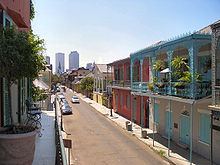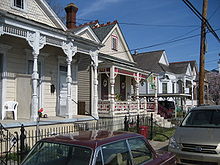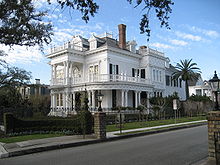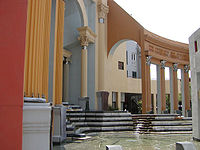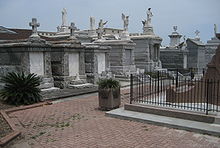- Buildings and architecture of New Orleans
-
The Buildings and architecture of New Orleans are reflective of the History of New Orleans and the city's multicultural heritage. New Orleans is world famous for its plethora of unique architectural styles, from creole cottages to the grand mansions on St. Charles, from the balconies of the French Quarter to an Egyptian Revival Customs House and a rare example of a Moorish revival church. The city boasts fine examples of almost every architectural style, from the Baroque Cabildo to the modernist skyscrapers of the Central Business District.
Contents
Domestic architectural styles
Creole Cottage
Creole cottages are scattered throughout the city of New Orleans, with most being built between 1790-1850. The majority of these cottages are found in the French Quarter, the surrounding areas of Faubourg Marigny, the Bywater and Esplanade Ridge. Creole Cottages are one-story, set at ground level. They have a steeply pitched roof, with a symmetrical four-opening facade wall, with a wood or stucco exterior. They are usually set close to the property line.
American Townhouse
Many buildings in the American Townhouse style were built in 1820-1850 and can be found in the Central Business District and Lower Garden District. American Townhouses are narrow, three-story structures made of stucco or brick. An asymmetrical arrangement of the facade with a balcony on the second floor sits close to the property line.
Creole Townhouse
Creole Townhouses are perhaps the most iconic pieces of architecture in the city of New Orleans, comprising a large portion of the French Quarter and the neighbouring Faubourg Marigny. Creole Townhouses were built after the Great New Orleans Fire (1788) until the mid-19th century. The previous wooden buildings were replaced with structures with courtyards, thick walls, arcades, and wrought iron balconies. The facade of the building sits on the property line, with an asymmetrical arrangement of arched openings. Creole Townhouses have a steeply pitched roof, side-gabled, with several roof dormers. The exterior is made of brick or stucco.
Shotgun House
Main article: Shotgun houseThe shotgun house is a narrow rectangular domestic residence, usually no more than 12 feet (3.5 m) wide, with doors at each end. This style of architecture developed in New Orleans, and is the city's predominant house type. Shotgun Houses were built from 1850 to 1910, and can be found throughout the city. Typically, Shotgun Houses are one-story, narrow rectangular houses raised on brick piers. Most have a narrow porch covered by a roof apron that is supported by columns and brackets, which are often ornamented with lacey Victorian motifs. Many variations of the Shotgun House exists, including Double Shotguns (essentially a duplex); Camelback house, also called Humpback, with a partial second floor on the end of the house; Double Width Shotgun, a single house twice the width of a normal shotgun; and "North shore" houses, with wide verandas on both sides, built north of Lake Pontchartrain in St. Tammany Parish.
Double-Gallery House
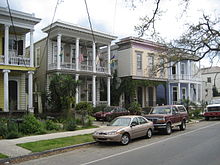 A row of Double-Gallery Houses on Esplanade Avenue, New Orleans
A row of Double-Gallery Houses on Esplanade Avenue, New Orleans
Double-Gallery Houses were built in New Orleans between 1820 and 1850. Double-Gallery Houses are two-story houses with a side-gabled or hipped roof. The house is set back from the property line, and has a covered two-story galleries which are framed and supported by columns supporting entablature. The façade has an asymmetrical arrangement of its openings. These were built as a variation of the American Townhouses in what was at that time considered the New Orleans suburbs of the Garden District, Uptown, and the Esplanade Ridge.
The California-style Bungalow House
Main article: California BungalowCalifornia Bungalow houses were built from the early-to-mid-20th century in neighborhoods such as Mid-City, Gentilly Terrace, Broadmoor, and scattered throughout older neighbourhoods as infill. California Bungalows are noted for their low slung appearance, being more horizontal than vertical. The exterior is often wood siding, with a brick, stucco, or stone porch with flared columns and roof overhang. Bungalows are one or one-and-a-half-story houses, with sloping roofs and eaves with unenclosed rafters, and typically feature a gable (or an attic vent designed to look like one) over main portion of the house.
New Orleans neighborhoods
French Quarter
Due to refurbishings in the Victorian Style after the Louisiana purchase, only a handful buildings in the French Quarter preserve their original Colonial Spanish or French architectural styles, concentrated mainly around the cathedral and Chartres Street. Most of the 2,900 buildings in the Quarter are either of "second generation" Creole or Greek revival styles. Fires in 1788 and 1794 destroyed many of the original French colonial buildings, that is, "first generation" Creole, mostly raised homes with wooden galleries, the last example being Madame John's Legacy, built during the Spanish rule in 1788 and still standing at 632 Dumaine Street. The Ursuline Convent (1745–1752) is the last intact example of French colonial architecture predating the city's transfer to Spain. Of the structures built during the French or Spanish colonial eras, only some 25 survived to this day (including the Cabildo and the Presbytère, in a mixture of colonial Spanish and neo-classical styles).
Two-thirds of the French Quarter structures date back from the first half of the 19th century, the most prolific decade being the 1820s, when the city was growing at an amazing rate. Records show that not a single Spanish architect was operating in the city : only French and American were, the latter gradually replacing the former as Creole style was being replaced by Greek revival architecture in the 1830s and 1840s. Spanish administrators did enforce strict building codes, requiring brick buildings to avoid another fire, but the Spaniards did not directly influence much of the Quarter's architecture. Spanish influence came indirectly with the form of Creole style, which mixed African, French, Spanish and Caribbean borrowings.
From its south end to the intersection with Claiborne Avenue, Canal Street is extremely dense with buildings. Each building, being no larger than half a New Orleans block has a notably intricate facade. All of these buildings contrast each other in style, from Greek revival, Art Nouveau, and Art Deco, to Renaissance Colonial, and one of Gothic architecture. Also there is Postmodern, Mid Century Modern, Streamline Moderne, and other types of 20th century architecture. However, most of these Buildings have lost their interiors because of Hurricane damage and Business renovations.
Jackson Square took its current form in the 1850s: the Cathedral was redesigned, mansard rooftops were added to the Cabildo and the Presbytère, and the Pontalba apartments were built on the sides of the square, adorned with wrought iron balconies. The trend of wrought and cast iron balconies in New Orleans can be traced back to this period.
St. Charles Avenue
Main article: St. Charles AvenueSt. Charles Avenue is famed for its large collection of southern mansions in various styles of architecture including Greek Revival, Colonial, and Victorian styles such as Italianate and Queen Anne Style.
The city of New Orleans was the largest in the Confederacy at the start of the American Civil War. The city was captured barely a year after the start of hostilities without combat in, or bombardment of the city itself. As a result, New Orleans retains the largest collection of surviving Antebellum architecture.
St. Charles Avenue is also home to neighboring Loyola University New Orleans and Tulane University, both which sit across the street from Audubon Park.
Central Business District
For much of its history, New Orleans' skyline consisted of only low and mid rise structures. The soft soils of New Orleans are susceptible to subsistence, and there was doubt about the feasibility of constructing large high rises in such an environment. The 1960s brought the trailblazing World Trade Center New Orleans and Plaza Tower which demonstrated that high-rise could stand firm on New Orleans' soil. One Shell Square took its place as the city's tallest building in 1972, a title it still holds. The oil boom of the early 1980s redefined New Orleans' skyline again with the development of the Poydras Street corridor. Today, New Orleans' high-rises are clustered along Canal Street and Poydras Street in the Central Business District.
Located within the Central Business District is one of the world's most famous pieces of Postmodern architecture, Charles Willard Moore's Piazza d'Italia.
The district has a number of significant historicist buildings. Perhaps the most notable are the Moorish revival Immaculate Conception Church and the Egyptian Revival United States Custom House (New Orleans).
Lafayette Square, New Orleans has some notable Art Deco civic buildings.
See also: List of tallest buildings in New OrleansCemeteries
New Orleans is famous for its elaborate European-style cemeteries, including Greenwood Cemetery, Saint Louis Cemeteries, and Metairie Cemetery. Because of New Orleans' high water table, graves are not dug "six feet under": stone tombs are the norm.
Preservation
Many organizations, notably the Preservation Resource Center, are devoted to promoting the preservation of historic neighborhoods and buildings in New Orleans. New Orleans has suffered from the same problems with sinking property values and urban decline as other major cities. Many historic structures have been threatened with demolition. During Hurricane Katrina and Hurricane Rita, several historic New Orleans neighborhoods were flooded, and numerous historic buildings were severely damaged. However, there is a general notion by both rebuilders and new developers to preserve the architectural integrity of the city.
Notable structures
- Ernest N. Morial Convention Center
- United States Custom House (New Orleans), notable Egyptian Revival building.
- Immaculate Conception Church (New Orleans), notable Moorish revival building.
See also
External links
- Vieux Carre Commission
- New Orleans Architecture
- Preservation Resource Center
- Southeastern Architectural Archive, Special Collections Division, Tulane University Libraries
References
Campanella, Richard, Geographies of New Orleans : Urban Fabrics before the Storm, Gretna, LA, Pelican Publishing, 2006.
Kingsley, Karen. Buildings of Louisiana, New York: Society of Architectural Historians, 2003.
Lewis, Peirce. New Orleans: The Making of an Urban Landscape, 2nd ed., Santa Fe, NM: Center for American Places, 2003.
City of New Orleans Topics History · Geography · Demographics · Economy · Culture · Healthcare · Media · Music · Sports · Architecture · Tourism · Education · Notable people · Skyscrapers · Streetcars · Flag · Lists

Government Neighborhoods Wards: 1st · 2nd · 3rd · 4th · 5th · 6th · 7th · 8th · 9th · 10th · 11th · 12th · 13th · 14th · 15th · 16th · 17th Categories:- Buildings and structures in New Orleans, Louisiana
- American architecture
Wikimedia Foundation. 2010.

